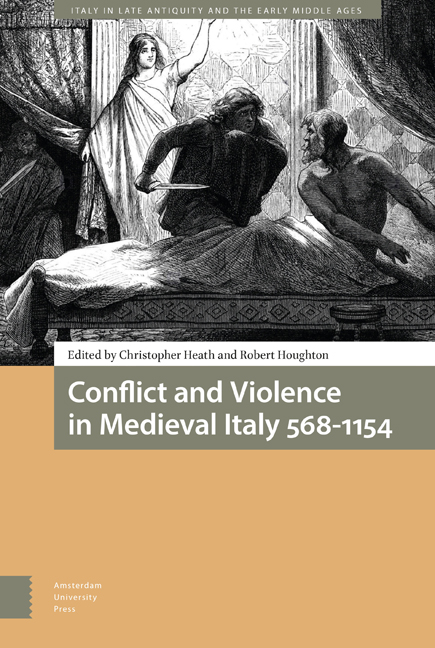Book contents
- Frontmatter
- Table of Contents
- Abbreviations
- Preface
- 1 Introduction: Discordant Minds and Hostile Nations
- 2 Morbidity and Murder: Lombard Kingship’s Violent Uncertainties 568-774
- 3 Insurgency and Counterinsurgency in Lombard Italy (c600-700)
- 4 Troubled Times: Narrating Conquest and Defiance between Charlemagne and Bernard (774-818)
- 5 ‘Nec patiaris populum Domini ab illis divinitus fulminandis Agarenis discerpi’: Handling ‘Saracen’ Violence in Ninth-Century Southern Italy
- 6 Formosus and the ‘Synod of the Corpse’: Tenth Century Rome in History and Memory
- 7 Sex, Denigration and Violence: A Representation of Political Competition between Two Aristocratic Families in Ninth Century Italy
- 8 ‘Italy and her [German] Invaders’: Otto III’s and Frederick Barbarossa’s Early Tours of Italy – Pomp, Generosity and Ferocity
- 9 ‘I Predict a Riot’: What Were the Parmense Rebelling Against in 1037?
- 10 The Strange Case of Deusdedit and Pandulf: Two Accounts of Honorius II’s Election
- Afterword
- Index
6 - Formosus and the ‘Synod of the Corpse’: Tenth Century Rome in History and Memory
Published online by Cambridge University Press: 07 September 2022
- Frontmatter
- Table of Contents
- Abbreviations
- Preface
- 1 Introduction: Discordant Minds and Hostile Nations
- 2 Morbidity and Murder: Lombard Kingship’s Violent Uncertainties 568-774
- 3 Insurgency and Counterinsurgency in Lombard Italy (c600-700)
- 4 Troubled Times: Narrating Conquest and Defiance between Charlemagne and Bernard (774-818)
- 5 ‘Nec patiaris populum Domini ab illis divinitus fulminandis Agarenis discerpi’: Handling ‘Saracen’ Violence in Ninth-Century Southern Italy
- 6 Formosus and the ‘Synod of the Corpse’: Tenth Century Rome in History and Memory
- 7 Sex, Denigration and Violence: A Representation of Political Competition between Two Aristocratic Families in Ninth Century Italy
- 8 ‘Italy and her [German] Invaders’: Otto III’s and Frederick Barbarossa’s Early Tours of Italy – Pomp, Generosity and Ferocity
- 9 ‘I Predict a Riot’: What Were the Parmense Rebelling Against in 1037?
- 10 The Strange Case of Deusdedit and Pandulf: Two Accounts of Honorius II’s Election
- Afterword
- Index
Summary
Abstract
This chapter unpicks the realities in the Italian peninsula in the late ninth century. The period is often depicted as one of crisis motivated by the end of the Carolingian experiment in Italy, and the continuance of a ‘war’ between the supporters of Guy of Spoleto and Berengar I. The papacy of Formusus must be seen in this context. An engagement with the issues that arise from the infamous Cadaver synod are provided with an analysis of the areas of interest that the trial of Formosus represents. A careful analysis of Liudprand of Cremona's work the Antapodosis allows us to see that he portrays the synod as a symbol of the corruption and decadence of the Roman aristocracy at this time.
Keywords: Papal history; post-Carolingian Italy; The Cadaver Synod; Formosus; Liudprand of Cremona; Antapodosis
Despite recent revisionist works, it seems quite difficult to argue with the idea that the break-up of the Carolingian Empire at the end of the ninth century led to something of a crisis in the Italian peninsula, including within the city of Rome. Although Giovanni Tabacco's description of the late ninth and early tenth centuries in Italy as ‘political anarchy’ may be overstating things, the disappearance of the more or less stable outside influence of the Carolingians does seem to have led to a quite striking level of instability and uncertainty among the civitates of Italy, in a way that should not be surprising when a polity is removed, willingly or otherwise, from a larger, more stable and secure union. Broadly speaking, the 880s and 890s can be summarised by the attempts at domination of Italian politics made by ‘French’ and ‘German’ factions, the leaders of which were Guy of Spoleto (889-94), and Berengar I (887-924), respectively. The late 880s and early 890s seem to have been, essentially, a quasi-civil war between these French and German factions. Although Berengar eventually won out by 898 (seemingly due principally to the death of most of his rivals, rather than any real competence on his part), it is very difficult to get away from a vision of a deeply uncertain and conflict-ridden late ninth century throughout most of Italy, including Rome.
- Type
- Chapter
- Information
- Conflict and Violence in Medieval Italy 568-1154 , pp. 185 - 204Publisher: Amsterdam University PressPrint publication year: 2021



